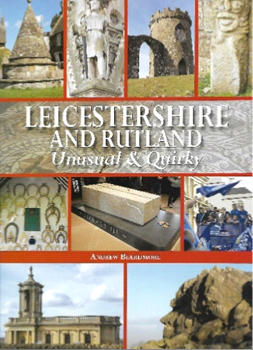
Researching Rutland
Copyright © Rutland Local History and Record Society. - All rights reserved
Registered Charity No 700273


Book Review
Leicestershire and Rutland Unusual and Quirky
By Andrew Beardmore
Published by Halsgrove in 2016. 160 pages, hardbound - ISBN-10: 0857042742. ISBN-13: 978-0857042743
Lurking
just
under
the
surface
of
Leicestershire
and
Rutland
is
a
host
of
oddities
and
peculiarities
that
turn
the
apparently
staid
and
conventional
into
something
much
more
intriguing.
Therefore
even
the
‘Conventional’
section
sees
its
County
History
interspersed
with
the
book's
idiosyncratic
‘Quirk
Alerts’,
such
as
anecdotes
covering
Roman
latrine
management,
how
Robin-a-Tiptoe
Hill
became
so-named,
and
the
meaning
of
bizarre
Leicestershire
terms
such
as ‘Gongoozlers’ and ‘Yawny Box’!
Naturally,
though,
it
is
the
‘Quirky’
section
where
things
turn
very
strange,
and
where
a
seemingly
random
almanac
of
55
Leicestershire
and
Rutland
places
have
their
quirkiest
facts
laid
bare:
like
which
village
has
a
cow-milking
organist,
which
had
a
beer-swilling
fox,
another
a
wig¬detecting
phantom,
and
yet
another
a
parson
who
tied
58
bulldogs
to
58
apple
trees
to
prevent scrumping!
Or
what
about
which
Leicestershire
village
was
hit
by
a
meteorite?
Which
one
saw
doves
dictate the build of a church, and which one still fights annually over a hare pie?
Alternatively,
find
out
which
Rutland
village
had
a
fourteenth-century
rector
involved
in
serious
organised
crime,
which
one
is
twinned
with
Paris,
and
which
one
is
home
to
a
truly
mind-blowing
historical
revelation.
If
you
think
you
know
Leicestershire
and
Rutland,
read
this
fascinating and profusely illustrated book and think again...



Researching Rutland
© Rutland Local History and Record Society
Registered Charity No 700273

Book Review
William Browne’s Town: The Stamford Hall Book 1465-1492
Stamford Survey Group in association with Stamford Town Council and
Stamford Civic Trust
Stamford is fortunate to have a Hall Book, a record of the council minutes
of the town. Until now it has remained in the town’s archives only to be
seen by historians with an appointment. With this transcript Alan Rogers
has made the first part of the Hall Book accessible to all and we are given
the opportunity to step back in time and discover what life was really like
in the fifteenth century. Future volumes are planned which will continue
the story of Stamford’s town affairs.
The book gives a remarkable insight into the lives of townspeople in
medieval England covering the years from 1465, shortly after the town’s
incorporation, until 1489 just after the death of William Browne. William
Browne was a very rich and important Merchant of the Staple. He
controlled the affairs of the town during this period, serving as Alderman
on several occasions. His legacy to Stamford is All Saints’ Church and
Browne’s Hospital.
As today, rules and regulations governed the lives of townsfolk. The
minutes record laws forbidding Sunday trading and fines for leaving
horses tied up in the wrong places on market days – as the editor
comments, ‘There were parking penalties even in medieval Stamford’. We
also find that there were designated places for dunghills and times when
animals could be brought into town. From this book we learn how law
and order was enforced and the punishments meted out to wrongdoers.
Perhaps the most interesting aspect of the volume is the tremendous
number of different trades pursued in the town. The wardens strictly
controlled the craftsmen to ensure the quality of goods and there was a
diversity of rules governing the guilds and the pageant of Corpus Christi.
Alan Rogers has had close links with Stamford and readers will no doubt
be familiar with his books The Medieval Buildings of Stamford
(Nottingham 1970), The Book of Stamford (Buckingham 1983) and, with
JS Hartley, The Religious Foundations of Medieval Stamford
(Nottingham 1974). He has also been closely involved with local history in
Rutland, most recently in Uppingham, inspiring and encouraging local
historians to record aspects of the history of that town.
For this volume Professor Rogers has written an excellent introduction
including the insight he has gained about the role of William Browne in
making the transcript. He also adds useful comments throughout the
volume and there is an excellent index. It is a shame that the Editorial
Conventions are not at the front of the book and a glossary would have
been useful for those less familiar with the legal terms of the medieval
period. Do not however be deterred by the plain cover: inside it is a
fascinating record not just for people in Stamford but for anyone
interested in town life in the Middle Ages. It is a book to dip into, and read
aloud it comes to life. It certainly merits a place on the bookshelf of
anyone interested in history.
Jean Orpin







